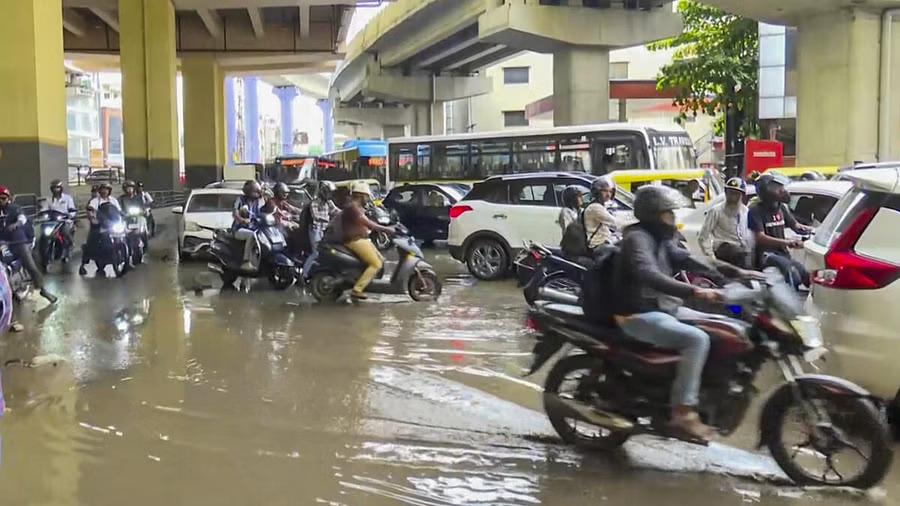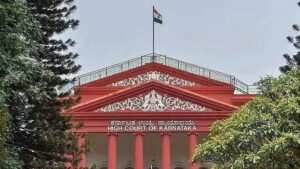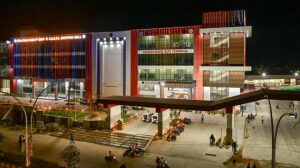Bengaluru, India’s Silicon Valley, was brought to a standstill as heavy pre-monsoon rains triggered widespread waterlogging, paralyzing traffic and exposing the city’s chronic infrastructure challenges. The deluge, part of a three-day spell of intense rainfall, submerged roads, flooded homes, and caused a tragic wall collapse in Whitefield Industrial Area, claiming the life of a 32-year-old woman. Home Minister G. Parameshwara acknowledged the crisis, stating that the Bruhat Bengaluru Mahanagara Palike (BBMP) and other authorities are actively clearing waterlogged areas and removing uprooted trees. However, with the India Meteorological Department (IMD) issuing a yellow alert for heavy rainfall across 23 Karnataka districts until May 21, Bengaluru’s residents face ongoing disruptions, raising urgent questions about urban planning, drainage systems, and civic preparedness.
The IMD reported that Bengaluru received 103 mm of rainfall in the 24 hours leading up to May 19, with cloudbursts dumping 15–20 cm of rain in some areas over the past few days. Low-lying neighborhoods like Sai Layout in Horamavu, part of the Mahadevapura zone, were among the worst hit, with streets submerged in 4–5 feet of water. Residents reported knee-deep flooding, blaming clogged drains and unaddressed complaints to civic authorities. In NC Colony on Tannery Road, water entered homes, damaging belongings, while boats were deployed in Horamavu to rescue stranded residents. Other affected areas included Sri Sai Layout, Rainbow Drive Layout, and Manyata Tech Park, where lake-like conditions disrupted daily life.
Traffic chaos gripped the city, with major bottlenecks at Silk Board Junction, Hebbal Junction, Koramangala, Indiranagar, and Electronics City Flyover. A viral photo posted by Bengaluru Corporate Club on X showed a 10-km traffic jam at Silk Board at 7:20 a.m. on May 19, a non-peak hour, highlighting the severity of the congestion. Commuters waded through knee-deep water at Panathur S Cross, the upper ramp of Domlur Flyover, and East End Road, pushing stranded vehicles. A video shared by a senior executive at a multi-billion-dollar company captured severe waterlogging under the Panathur railway underbridge, with muddy, clay-covered roads making travel hazardous. Underpasses, notorious for flooding, became impassable, prompting hobby weather watchers to advocate for work-from-home arrangements to avoid dangerous commutes.
The rains also caused property damage and safety hazards. In Jayanagar, an uprooted tree fell on a parked car and jeep, while another tree blocked East End Road near Mount Carmel School, temporarily closing the stretch. The IMD’s yellow alert, issued on May 18, warned of moderate to heavy thundershowers, lightning, and gusty winds of 50–60 km/h, predicting temporary power outages and further tree falls. The alert covers Bengaluru Urban, Bengaluru Rural, Kolar, Chikkaballapura, Tumakuru, Mandya, Mysuru, Hassan, Kodagu, Belagavi, Bidar, Raichur, Yadgir, Davanagere, and Chitradurga, driven by an upper-air cyclonic circulation over the Southeast Bay of Bengal and a trough from Telangana to North Tamil Nadu.
Bengaluru’s drainage woes are not new. The city’s storm water drains (SWDs), often clogged with silt and debris, fail to handle sudden downpours, a problem exacerbated by rapid urbanization and concretization. Residents of Sai Layout have long complained about neglected drains, with unheeded calls for maintenance. Urban expert RK Mishra, in a 2023 interview, criticized Bengaluru’s lack of proper footpaths and public transport, attributing traffic woes to poor governance. The BBMP, responsible for civic infrastructure, has faced accusations of negligence, with a 2021 campaign by BangaloreRepair challenging then-Chief Minister Basavaraj Bommai to witness the city’s pothole-ridden, waterlogged roads. Despite assurances, deadlines for repairs, like one set for October 2021, have repeatedly been missed, often blamed on heavy rains.
The current crisis has reignited public frustration, amplified on social media. X posts from May 19, 2025, flooded with videos of submerged streets, with users decrying the city’s collapse during rains. One user remarked, “A mere hour of rain in North Bangalore exposes no drainage infrastructure,” while another described the Panathur underbridge as a “crazy bad road” worsened by monsoon conditions. The Bengaluru Traffic Police issued constant alerts, advising alternate routes and reporting slow-moving traffic at Nagawara, Hebbal, and KR Puram. In response, the South Division Traffic Police implemented a special management plan, but commuters still faced hours-long delays.
Political leaders have acknowledged Bengaluru’s infrastructure limits. In February 2025, Home Minister Parameshwara noted that the city, with 1.4 crore people and an equal number of vehicles, was not built for its current population density. Deputy Chief Minister D.K. Shivakumar, in the same month, admitted that “even God can’t fix Bengaluru’s traffic,” projecting a three-year timeline for relief through projects like tunnel roads and elevated corridors. However, delays due to financial, technical, and land acquisition issues have slowed progress. Union Minister Nitin Gadkari, in 2023, suggested double-decker buses and flyovers to ease congestion, citing space constraints for road expansion. These long-term plans offer little immediate respite for residents navigating the current chaos.
The economic impact is significant. Bengaluru, contributing 25% of India’s software exports, relies on its tech corridors like Outer Ring Road (ORR) and Manyata Tech Park, both severely affected by flooding. In 2022, ORRCA advised tech workers to work from home after Halanayakanahalli Lake overflowed, and similar calls emerged in 2025 as underpasses and tech hubs became inaccessible. The flooding of Manyata Tech Park, a hub for multinational companies, disrupted operations, while airport-bound traffic faced delays due to waterlogging on International Airport Road. The city’s reputation as a global IT hub is at risk when pre-monsoon rains routinely halt daily life.
Solutions require systemic change. Experts like Professor M.N. Sreehari, a traffic advisor, have criticized BBMP’s use of substandard materials and poor planning in drain construction. Sandeep Anirudhan, founder of Citizens’ Agenda for Bengaluru, emphasized the lack of coordination and accountability in civic projects. Proposed measures include desilting SWDs, enforcing anti-encroachment policies near drains, and investing in modern drainage systems. Short-term actions, like deploying pumps at underpasses and clearing debris, are underway, but long-term urban planning—integrating green spaces, permeable surfaces, and robust public transport—is critical. The BBMP’s sale of fallen branches on-site, introduced in 2024, aims to manage tree collapses efficiently, but broader infrastructure upgrades are needed.
As Bengaluru braces for more rain, the immediate focus is on clearing roads and ensuring safety. The BBMP’s efforts, while ongoing, face scrutiny for their pace and effectiveness. For residents, the pre-monsoon havoc is a stark reminder of the city’s vulnerability, prompting calls for accountability and innovative solutions. Bengaluru’s ambition to remain a global tech leader hinges on its ability to address these civic challenges, ensuring that its roads—and its future—are no longer at the mercy of the rains.
Sponsored
FACTS Transcripts
Apply for a University document anywhere
https://www.factstranscript.com
Quick Transcripts for popular Universities, check your University name now and get started. We help you to get your transcript application online which is accepted for use of IRCC.
No DD, NO Paperwork. 100% Authentic, Reliable.
FACTS Transcripts Charges · Reviews · Assam Universities · Home · Know your University









